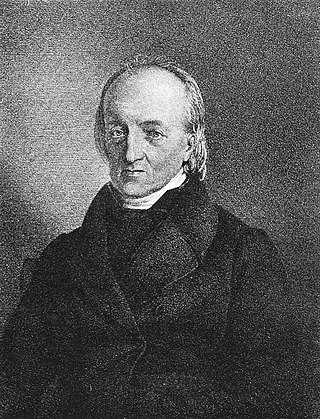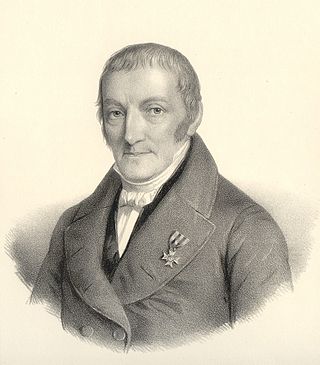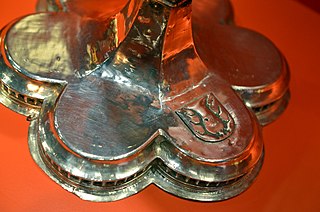
Philipp Emanuel von Fellenberg was a Swiss educationalist and agronomist.

Karl Ludwig von Haller was a Swiss jurist, statesman and political philosopher. He was the author of Restauration der Staatswissenschaft, a book which gave its namesake to the Restoration period after the Congress of Vienna, and which Georg Wilhelm Friedrich Hegel strongly criticized in §258 of Elements of the Philosophy of Right.

The English name of Switzerland is a compound containing Switzer, an obsolete term for the Swiss, which was in use during the 16th to 19th centuries. The English adjective Swiss is a loan from French Suisse, also in use since the 16th century.

Franz Bucher is a Swiss artist. He has produced paintings, drawings, woodcuts, etchings, sculptural objects, reliefs, murals, and stained glass.

Rüti Monastery was a former Premonstratensian monastery, founded in 1206 and suppressed in 1525 on occasion of the Reformation in Zürich, situated in the municipality of Rüti in the canton of Zürich, Switzerland. The monastery's church was the final resting place of the Counts of Toggenburg, among them Count Friedrich VII and 13 other members of the Toggenburg family, and other noble families. Between 1206 and 1525, the monastery comprised 14 incorporated churches and the owner of extensive lands and estates at 185 localities.

Albrecht von Bonstetten was a Swiss humanist of the later 15th century. A member of the baronial von Bonstetten family, he entered Einsiedeln Abbey at a young age, and after studies in Fribourg and Basel he returned to Einsiedeln and was made deacon in 1469. He studied canon law at Pavia and was ordained a priest in 1474, and he received the title of doctor utriusque iuris from Emperor Maximilian in 1498. He published a biography on Nicholas of Flüe called Historia fratris Nicholai in 1479.

Franz Rudolf Frisching (1733–1807) was a Bernese patrician, officer, politician and industrialist.

The transalpine campaigns of the Old Swiss Confederacy were military expeditions which resulted in the conquest of territories south of the Alps, corresponding more or less to the modern canton of Ticino, on the part of the Old Swiss Confederacy in the 15th and 16th centuries. These territories were known as ennetbirgische Vogteien or "transmontane bailiwicks".

Casimir Pfyffer von Altishofen was a Swiss politician and jurist. He was mayor of Lucerne (1832–1835), President of the Swiss National Council (1854/1855) and five times President of the Federal Supreme Court.

Theophil Spoerri, was a Swiss writer and academic.

Münsterbrücke is a pedestrian and road bridge over the Limmat in the city of Zürich, Switzerland. It is listed in the Swiss inventory of cultural property of national and regional significance. It is indirectly named after two Münster (minsters), the Fraumünster and Grossmünster.

Elisabeth von Matsch was the last countess of the Swiss noble House of Toggenburg from 1436. She was the spouse of Friedrich VII, count of Toggenburg.

The Second Battle of Ulrichen was a battle fought in 1419 between the Old Swiss Confederacy led by Bern and rebels from Valais near Ulrichen in the district of Goms in the canton of Valais in Switzerland. Negotiations after the battle led to the end of the Raron affair and self-determination for Valais.
Monika Dettwiler is a Swiss-Italian journalist and author.

The Bernese Jura Railway was a railway company in Switzerland. The company was called the Jura–Bern–Luzern from 1 July 1884. The Jura–Bern–Lucerne merged with the Western Switzerland–Simplon Railways to form the Jura–Simplon Railway (Jura-Simplon-Bahn), JS) on 1 January 1890.
The Bern-Lucerne Railway was a railway company in Switzerland, which opened the Langnau–Lucerne line, now part of the Bern–Lucerne railway, on 1 August 1875. It was taken over by the Jura–Simplon Railways on 1 January 1890.
Albert Steck was a Swiss politician and co-founder of the Social Democratic Party of Switzerland.
Rea Brändle was a Swiss journalist and writer.
Cäsar von Arx was a Swiss theatre producer and dramatist.

The Schaffhausen massacre was an anti-Semitic episode in Schaffhausen, in present-day Switzerland, which occurred in 1401. An episode of antisemitism had already occurred in Schaffhausen 52 years prior, when the local Jews were accused of well poisoning and burned alive on 22 February 1349. On this occasion, the Jews were accused of the murder of a four-year-old boy, Konrad Lori from Diessenhofen. "Confessions" were obtained from them under torture, and on 25 June 1401 they were executed by burning.















